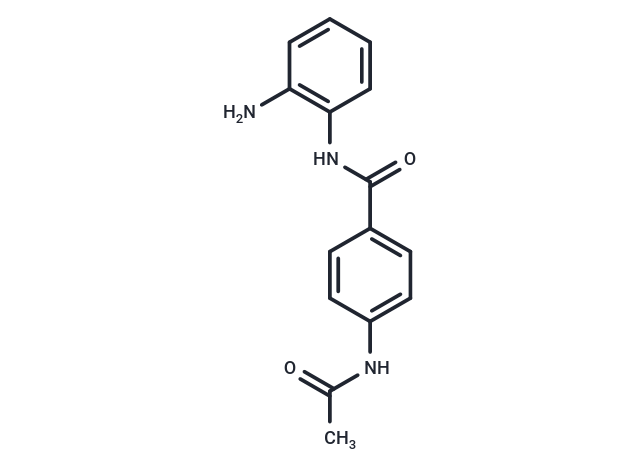Shopping Cart
- Remove All

Your shopping cart is currently empty


| Pack Size | Price | Availability | Quantity |
|---|---|---|---|
| 10 mg | $43 | In Stock | |
| 50 mg | $66 | In Stock | |
| 100 mg | $97 | In Stock | |
| 200 mg | $171 | In Stock | |
| 500 mg | $369 | In Stock | |
| 1 mL x 10 mM (in DMSO) | $48 | In Stock |
| Description | Tacedinaline (CI994) is a selective class I HDAC inhibitor with potential antineoplastic activity. |
| In vitro | In models of chemotherapy-resistant pancreatic ductal adenocarcinoma in mice and human prostate tumor, CI-994 consistently demonstrated antitumor activity. |
| In vivo | CI-994 exhibits antitumor activity, displaying enhanced cytocidal effects in solid tumors. It inhibits cell growth across various cell types, including rat leukemia BCLO cells (IC50=2.5 µM) and LNCaP cells (IC50=7.4 µM). In A-549 and LX-1 cells, CI-994 (<160 mM) increases the number of cells in the G0/G1 phase while decreasing those in the S phase, effectively inhibiting cell growth and inducing apoptosis. |
| Cell Research | LNCaP cell lines are maintained in RPMI 1640 medium containing 10% fetal bovine serum, 1% penicillin and streptomycin, as the complete culture medium. Cells (2×104) are seeded in 24-well plates and incubated in a 5% CO2 incubator at 37 °C for 1 day. Cultures are treated with CI-994, alone and in combination on day 2 and 4. Cells are washed on day 2 and 4 and media are changed. Mitochondrial metabolism is measured as a marker for cell growth by adding 100 μL/well MTT (5 mg/mL in medium) with 2 hours incubation at 37 °C on Day 6. Crystals formed are dissolved in 500 μL of DMSO. The absorbance is determined using a microplate reader at 560 nm. The absorbance data are converted into cell proliferation percentage. Each assay is performed in triplicate. (Only for Reference) |
| Alias | Acetyldinaline, N-acetyldinaline, PD-123654, CI994, Goe-5549 |
| Molecular Weight | 269.3 |
| Formula | C15H15N3O2 |
| Cas No. | 112522-64-2 |
| Storage | Powder: -20°C for 3 years | In solvent: -80°C for 1 year | |||||||||||||||||||||||||||||||||||
| Solubility Information | DMSO: 26.9 mg/mL (100 mM) | |||||||||||||||||||||||||||||||||||
Solution Preparation Table | ||||||||||||||||||||||||||||||||||||
DMSO
| ||||||||||||||||||||||||||||||||||||

Copyright © 2015-2024 TargetMol Chemicals Inc. All Rights Reserved.